impact KIA Spectra 2008 2.G Owner's Manual
[x] Cancel search | Manufacturer: KIA, Model Year: 2008, Model line: Spectra, Model: KIA Spectra 2008 2.GPages: 298, PDF Size: 5.38 MB
Page 30 of 298
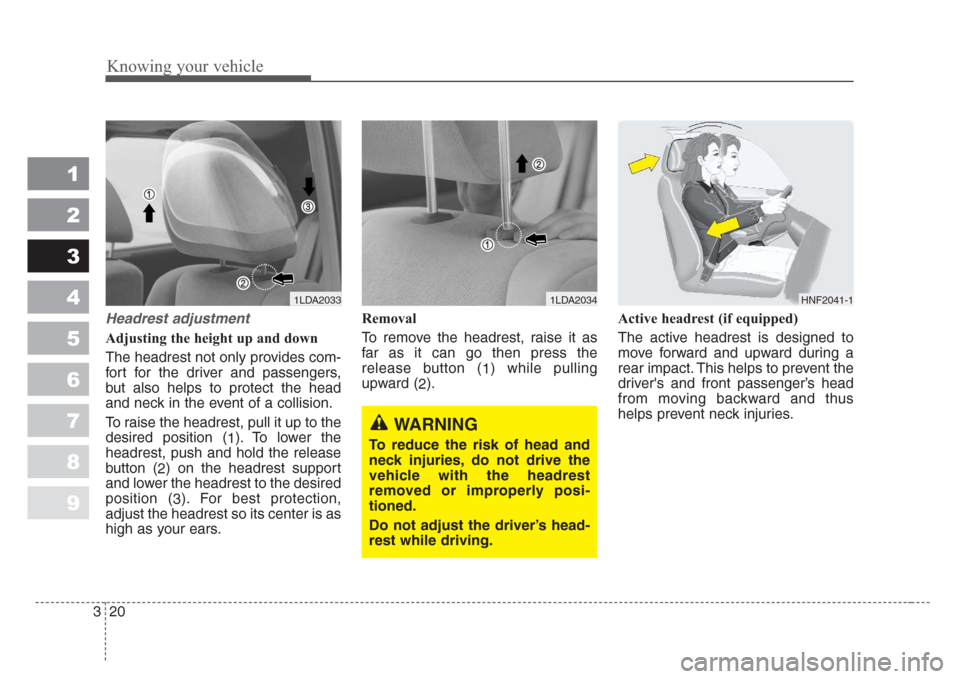
Knowing your vehicle
20 3
1
2
3
4
5
6
7
8
9
Headrest adjustment
Adjusting the height up and down
The headrest not only provides com-
fort for the driver and passengers,
but also helps to protect the head
and neck in the event of a collision.
To raise the headrest, pull it up to the
desired position (
1). To lower the
headrest, push and hold the release
button (
2) on the headrest support
and lower the headrest to the desired
position (
3). For best protection,
adjust the headrest so its center is as
high as your ears.Removal
To remove the headrest, raise it as
far as it can go then press the
release button (
1) while pulling
upward (
2).Active headrest (if equipped)
The active headrest is designed to
move forward and upward during a
rear impact. This helps to prevent the
driver's and front passenger’s head
from moving backward and thus
helps prevent neck injuries.
1LDA20331LDA2034
WARNING
To reduce the risk of head and
neck injuries, do not drive the
vehicle with the headrest
removed or improperly posi-
tioned.
Do not adjust the driver’s head-
rest while driving.
HNF2041-1
Page 33 of 298

323
1
2
3
4
5
6
7
8
9
Knowing your vehicle
Active headrest (if equipped)
The active headrest is designed to
move forward and upward during a
rear impact. This helps to prevent the
driver's and front passenger’s head
from moving backward and thus
helps prevent neck injuries.
Rear seat
Split folding rear seat
(if equipped)
The rear seatbacks fold forward to
provide additional cargo space and
to provide access to the cargo area.
• To fold the rear seatback(s) down,
pull the lock release lever, then fold
the seatback forward and down.
• To raise the seatback, lift and push
it firmly until it clicks into place.
• When you return the seatback to
its upright position, reposition the
rear safety belts so that they can
be used by rear seat passengers.
4 Door (if equipped)
1. Pull the lock release lever.
2. Move the rear three-point seat
belts to the outside (1) so that they
don’t interfere with the seatback
when lowering.
3. Fold the seatback forward and
down firmly (2).
1LDN2038
1LDN3025
HNF2041-1
Page 46 of 298
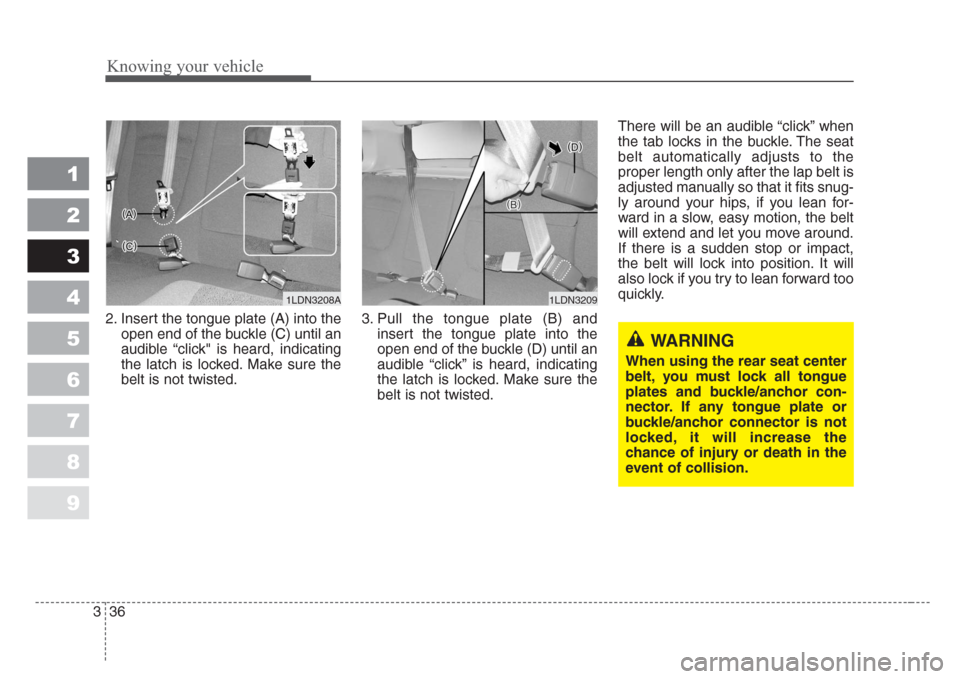
Knowing your vehicle
36 3
1
2
3
4
5
6
7
8
9
2. Insert the tongue plate (A) into the
open end of the buckle (C) until an
audible “click" is heard, indicating
the latch is locked. Make sure the
belt is not twisted.3. Pull the tongue plate (B) and
insert the tongue plate into the
open end of the buckle (D) until an
audible “click” is heard, indicating
the latch is locked. Make sure the
belt is not twisted.There will be an audible “click” when
the tab locks in the buckle. The seat
belt automatically adjusts to the
proper length only after the lap belt is
adjusted manually so that it fits snug-
ly around your hips, if you lean for-
ward in a slow, easy motion, the belt
will extend and let you move around.
If there is a sudden stop or impact,
the belt will lock into position. It will
also lock if you try to lean forward too
quickly.
1LDN3209
WARNING
When using the rear seat center
belt, you must lock all tongue
plates and buckle/anchor con-
nector. If any tongue plate or
buckle/anchor connector is not
locked, it will increase the
chance of injury or death in the
event of collision.
1LDN3208A
Page 48 of 298
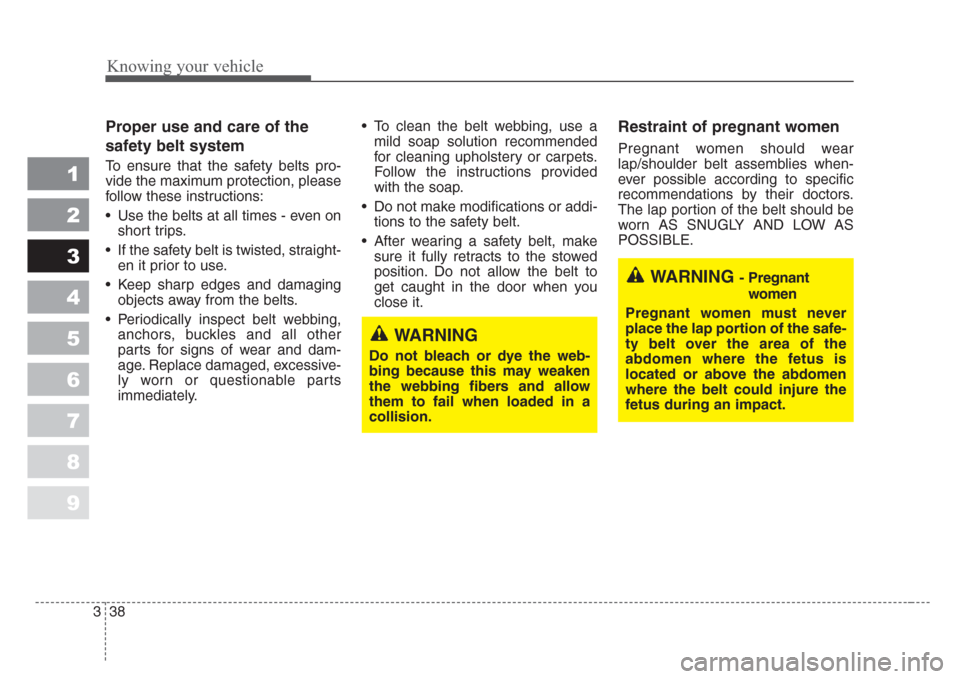
Knowing your vehicle
38 3
1
2
3
4
5
6
7
8
9
Proper use and care of the
safety belt system
To ensure that the safety belts pro-
vide the maximum protection, please
follow these instructions:
• Use the belts at all times - even on
short trips.
• If the safety belt is twisted, straight-
en it prior to use.
• Keep sharp edges and damaging
objects away from the belts.
• Periodically inspect belt webbing,
anchors, buckles and all other
parts for signs of wear and dam-
age. Replace damaged, excessive-
ly worn or questionable parts
immediately.• To clean the belt webbing, use a
mild soap solution recommended
for cleaning upholstery or carpets.
Follow the instructions provided
with the soap.
• Do not make modifications or addi-
tions to the safety belt.
• After wearing a safety belt, make
sure it fully retracts to the stowed
position. Do not allow the belt to
get caught in the door when you
close it.
Restraint of pregnant women
Pregnant women should wear
lap/shoulder belt assemblies when-
ever possible according to specific
recommendations by their doctors.
The lap portion of the belt should be
worn AS SNUGLY AND LOW AS
POSSIBLE.
WARNING - Pregnant
women
Pregnant women must never
place the lap portion of the safe-
ty belt over the area of the
abdomen where the fetus is
located or above the abdomen
where the belt could injure the
fetus during an impact.
WARNING
Do not bleach or dye the web-
bing because this may weaken
the webbing fibers and allow
them to fail when loaded in a
collision.
Page 53 of 298
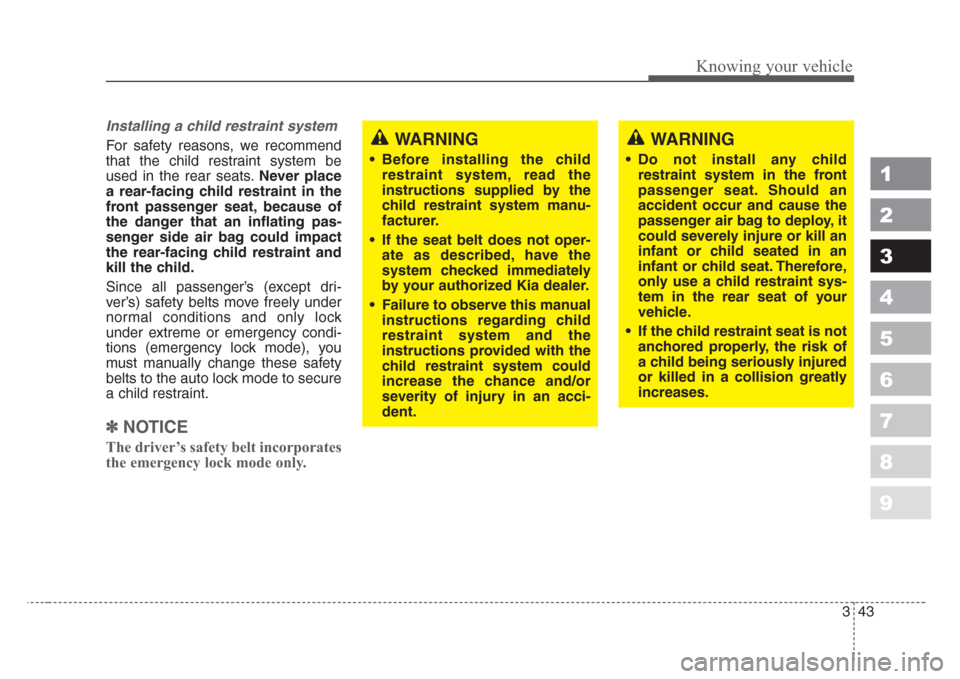
343
1
2
3
4
5
6
7
8
9
Knowing your vehicle
Installing a child restraint system
For safety reasons, we recommend
that the child restraint system be
used in the rear seats.Never place
a rear-facing child restraint in the
front passenger seat, because of
the danger that an inflating pas-
senger side air bag could impact
the rear-facing child restraint and
kill the child.
Since all passenger’s (except dri-
ver’s) safety belts move freely under
normal conditions and only lock
under extreme or emergency condi-
tions (emergency lock mode), you
must manually change these safety
belts to the auto lock mode to secure
a child restraint.
✽
NOTICE
The driver’s safety belt incorporates
the emergency lock mode only.
WARNING
• Do not install any child
restraint system in the front
passenger seat. Should an
accident occur and cause the
passenger air bag to deploy, it
could severely injure or kill an
infant or child seated in an
infant or child seat. Therefore,
only use a child restraint sys-
tem in the rear seat of your
vehicle.
• If the child restraint seat is not
anchored properly, the risk of
a child being seriously injured
or killed in a collision greatly
increases.
WARNING
• Before installing the child
restraint system, read the
instructions supplied by the
child restraint system manu-
facturer.
• If the seat belt does not oper-
ate as described, have the
system checked immediately
by your authorized Kia dealer.
• Failure to observe this manual
instructions regarding child
restraint system and the
instructions provided with the
child restraint system could
increase the chance and/or
severity of injury in an acci-
dent.
Page 60 of 298

Knowing your vehicle
50 3
1
2
3
4
5
6
7
8
9
AIR BAG - ADVANCED SUPPLEMENTAL RESTRAINT SYSTEM
1JBN3511A/OMGA035047/OMGA035048/OMGA035049/OMGA035051/OMGA035052/OMGA035053/OMGA035055/OMGA035054/1LDN2166/1LDN2167/1LDN2168
123
5
4
7
(1) Driver’s air bag
(2) Front passenger’s air bag
(3) Side air bag*
(4) Curtain air bag*
(5) SRS Control Module
(6) Side impact sensor*
(7) Front impact sensor
(8) Front seat position sensor
(9) Occupant classification system
* : if equipped
986
Page 61 of 298

351
1
2
3
4
5
6
7
8
9
Knowing your vehicle
What your air bag system
does
Driver’s air bag and front passen-
ger’s air bag are designed to supple-
ment the protection offered by the
safety belt in certain frontal colli-
sions. Likewise, side air bag and cur-
tain air bags are designed to supple-
ment the protection offered by the
safety belt in side collisions. Safety
belts are designed to reduce the
injury of the driver or passengers in
case of impact or collision. No safety
belt or air bag system can complete-
ly eliminate injuries that may cause
in collisions or impacts. To help
reduce impact on driver or passen-
gers in any collision, safety belts
must be correctly worn.
What your air bag system
does not do
The air bag system is designed to
supplement the protection offered by
the safety belt system.IT IS NOT A
SUBSTITUTE FOR THE SAFETY
BELT.
The importance of using
safety belts
There are four very important rea-
sons to use safety belts even with an
air bag supplemental restraint sys-
tem. They:
• help keep you in the proper posi-
tion (away from the air bag) when it
inflates.
• reduce the risk of harm in rollover,
side impact (vehicles not equipped
with side and curtain air bags) or
rear impact collisions, because an
air bag is not designed to inflate in
such situations and even a side
curtain air bag is designed to
inflate only in certain side impact
collisions.
• reduce the risk of harm in frontal or
side collisions which are not
severe enough to actuate the air
bag supplemental restraint system.
• reduce the risk of being ejected
from your vehicle.
Page 62 of 298
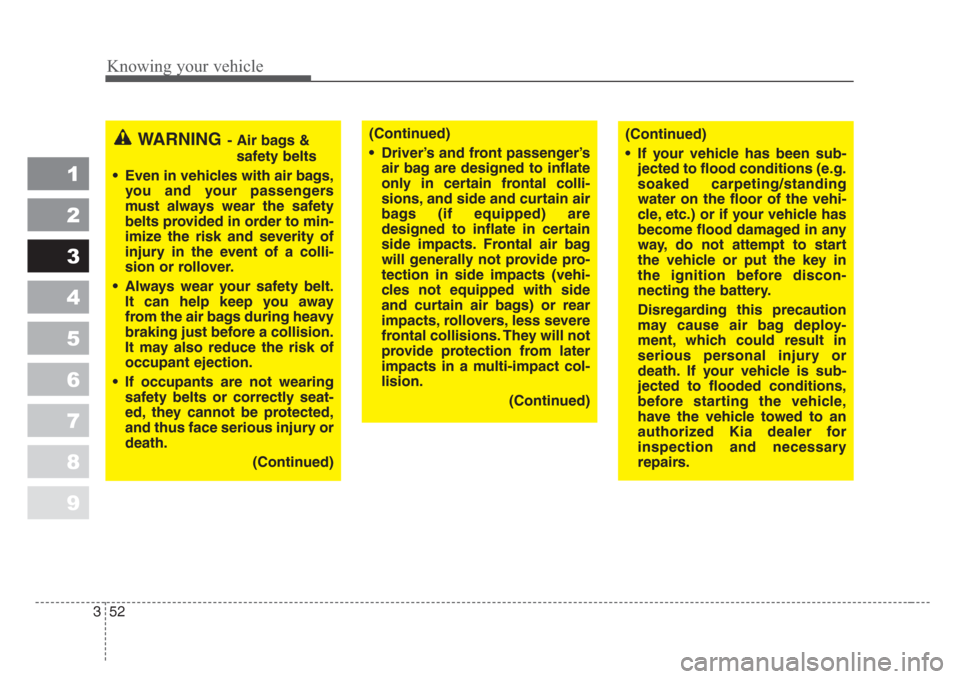
Knowing your vehicle
52 3
1
2
3
4
5
6
7
8
9
WARNING- Air bags &
safety belts
• Even in vehicles with air bags,
you and your passengers
must always wear the safety
belts provided in order to min-
imize the risk and severity of
injury in the event of a colli-
sion or rollover.
•Always wear your safety belt.
It can help keep you away
from the air bags during heavy
braking just before a collision.
It may also reduce the risk of
occupant ejection.
• If occupants are not wearing
safety belts or correctly seat-
ed, they cannot be protected,
and thus face serious injury or
death.
(Continued)(Continued)
• Driver’s and front passenger’s
air bag are designed to inflate
only in certain frontal colli-
sions, and side and curtain air
bags (if equipped) are
designed to inflate in certain
side impacts. Frontal air bag
will generally not provide pro-
tection in side impacts (vehi-
cles not equipped with side
and curtain air bags) or rear
impacts, rollovers,less severe
frontal collisions. They will not
provide protection from later
impacts in a multi-impact col-
lision.
(Continued)(Continued)
• If your vehicle has been sub-
jected to flood conditions (e.g.
soaked carpeting/standing
water on the floor of the vehi-
cle, etc.) or if your vehicle has
become flood damaged in any
way, do not attempt to start
the vehicle or put the key in
the ignition before discon-
necting the battery.
Disregarding this precaution
may cause air bag deploy-
ment, which could result in
serious personal injury or
death. If your vehicle is sub-
jected to flooded conditions,
before starting the vehicle,
have the vehicle towed to an
authorized Kia dealer for
inspection and necessary
repairs.
Page 63 of 298
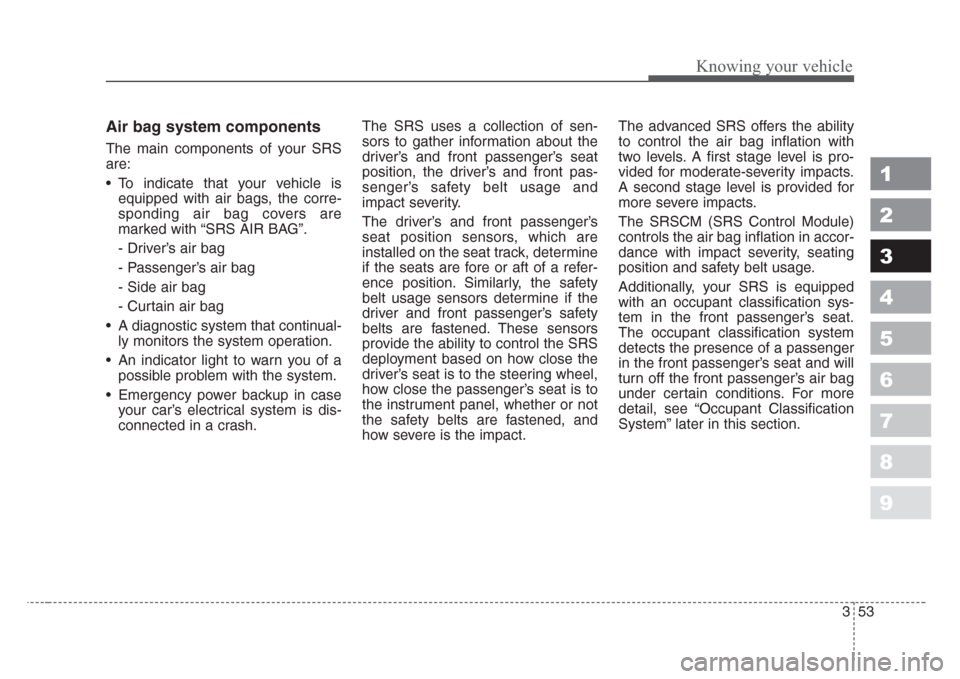
353
1
2
3
4
5
6
7
8
9
Knowing your vehicle
Air bag system components
The main components of your SRS
are:
• To indicate that your vehicle is
equipped with air bags, the corre-
sponding air bag covers are
marked with “SRS AIR BAG”.
- Driver’s air bag
- Passenger’s air bag
- Side air bag
- Curtain air bag
• A diagnostic system that continual-
ly monitors the system operation.
• An indicator light to warn you of a
possible problem with the system.
• Emergency power backup in case
your car’s electrical system is dis-
connected in a crash.The SRS uses a collection of sen-
sors to gather information about the
driver’s and front passenger’s seat
position, the driver’s and front pas-
senger’s safety belt usage and
impact severity.
The driver’s and front passenger’s
seat position sensors, which are
installed on the seat track, determine
if the seats are fore or aft of a refer-
ence position. Similarly, the safety
belt usage sensors determine if the
driver and front passenger’s safety
belts are fastened. These sensors
provide the ability to control the SRS
deployment based on how close the
driver’s seat is to the steering wheel,
how close the passenger’s seat is to
the instrument panel, whether or not
the safety belts are fastened, and
how severe is the impact.The advanced SRS offers the ability
to control the air bag inflation with
two levels. A first stage level is pro-
vided for moderate-severity impacts.
A second stage level is provided for
more severe impacts.
The SRSCM (SRS Control Module)
controls the air bag inflation in accor-
dance with impact severity, seating
position and safety belt usage.
Additionally, your SRS is equipped
with an occupant classification sys-
tem in the front passenger’s seat.
The occupant classification system
detects the presence of a passenger
in the front passenger’s seat and will
turn off the front passenger’s air bag
under certain conditions. For more
detail, see “Occupant Classification
System” later in this section.
Page 72 of 298
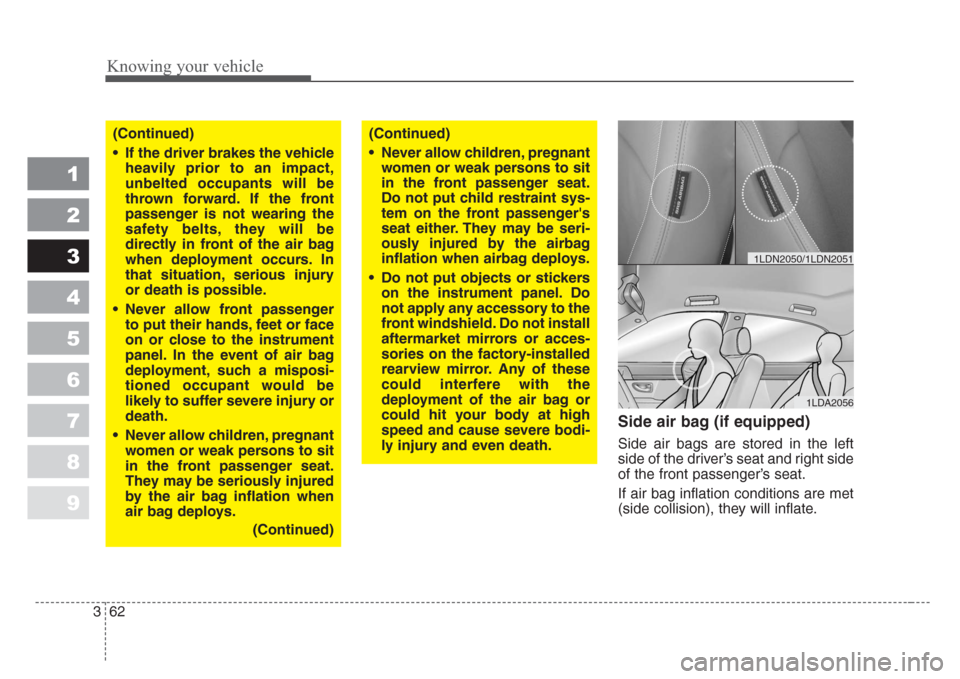
Knowing your vehicle
62 3
1
2
3
4
5
6
7
8
9
Side air bag (if equipped)
Side air bags are stored in the left
side of the driver’s seat and right side
of the front passenger’s seat.
If air bag inflation conditions are met
(side collision), they will inflate.
1LDA2056
1LDN2050/1LDN2051
(Continued)
• If the driver brakes the vehicle
heavily prior to an impact,
unbelted occupants will be
thrown forward. If the front
passenger is not wearing the
safety belts, they will be
directly in front of the air bag
when deployment occurs.In
that situation,serious injury
or death is possible.
• Never allow front passenger
to put their hands, feet or face
on or close to the instrument
panel. In the event of air bag
deployment,such a misposi-
tioned occupant would be
likely to suffer severe injury or
death.
• Never allow children, pregnant
women or weak persons to sit
in the front passenger seat.
They may be seriously injured
by the air bag inflation when
air bag deploys.
(Continued)(Continued)
• Never allow children, pregnant
women or weak persons to sit
in the front passenger seat.
Do not put child restraint sys-
tem on the front passenger's
seat either. They may be seri-
ously injured by the airbag
inflation when airbag deploys.
• Do not put objects or stickers
on the instrument panel. Do
not apply any accessory to the
front windshield. Do not install
aftermarket mirrors or acces-
sories on the factory-installed
rearview mirror. Any of these
could interfere with the
deployment of the air bag or
could hit your body at high
speed and cause severe bodi-
ly injury and even death.